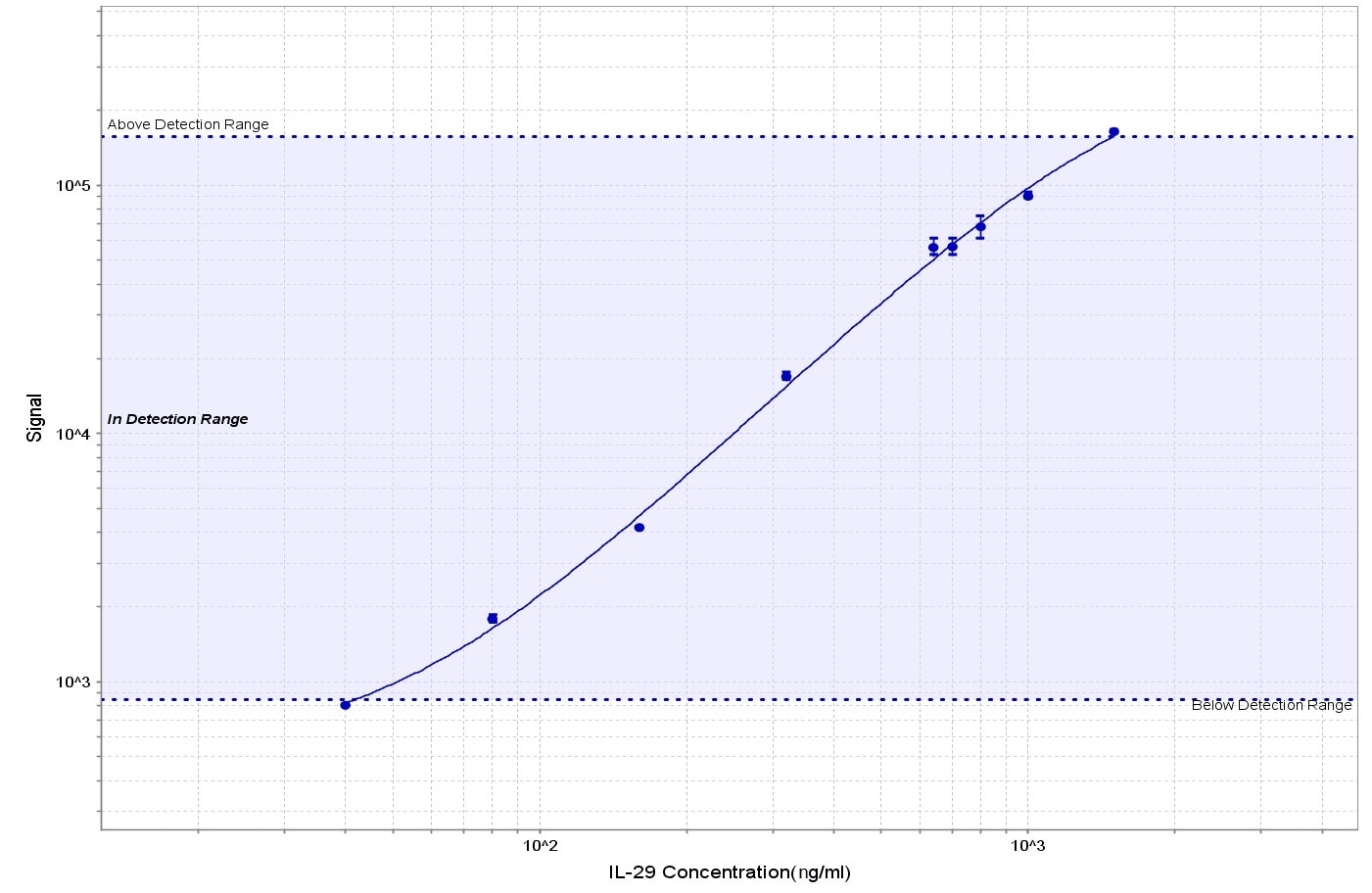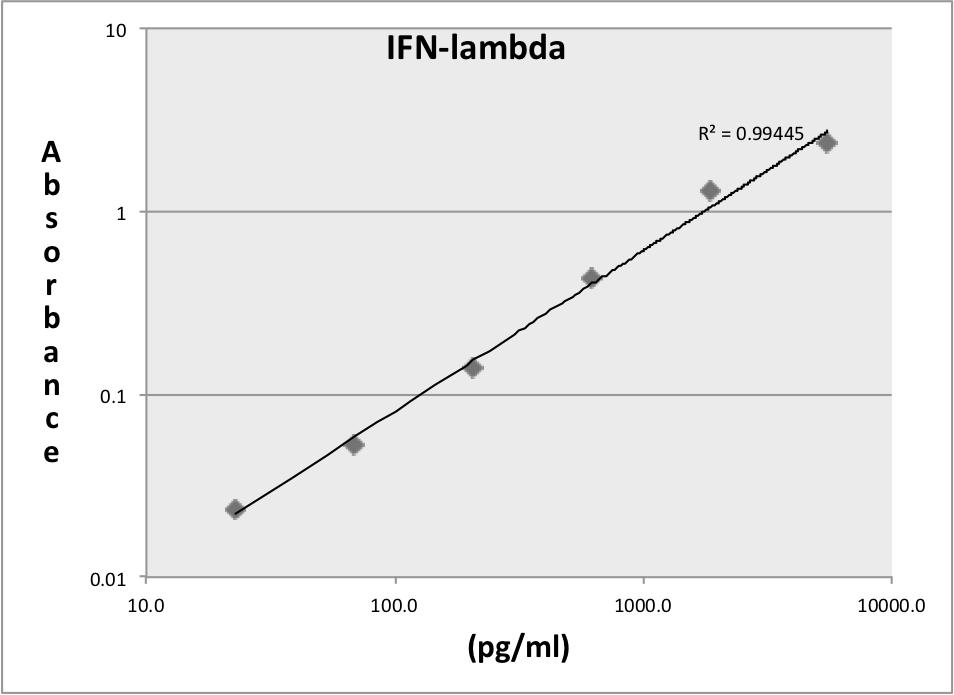Human IL-29/IFN-lambda 1 Antibody Summary
Gly20-Thr200
Accession # Q8IU54
Applications
IL-29/IFN-lambda 1 Sandwich Immunoassay
Please Note: Optimal dilutions should be determined by each laboratory for each application. General Protocols are available in the Technical Information section on our website.
Scientific Data
 View Larger
View Larger
IL‑29/IFN‑ lambda 1 Inhibition of EMCV‑induced Cytopathy and Neutralization by Human IL‑29/IFN‑ lambda 1 Antibody. Recombinant Human IL-29/IFN-lambda 1 (Catalog # 1598-IL) reduces the Encephalomyocarditis Virus (EMCV)-induced cytopathy in the HepG2 human hepatocellular carcinoma cell line in a dose-dependent manner (orange line). Inhibition of EMCV activity elicited by Recombinant Human IL-29/IFN-lambda 1 (40 ng/mL) is neutralized (green line) by increasing concentrations of Mouse Anri-Human IL-29/IFN-lambda 1 Monoclonal Antibody (Catalog # MAB15981). The ND50 is typically 1-4 µg/mL.
Preparation and Storage
- 12 months from date of receipt, -20 to -70 °C as supplied.
- 1 month, 2 to 8 °C under sterile conditions after reconstitution.
- 6 months, -20 to -70 °C under sterile conditions after reconstitution.
Background: IL-29/IFN-lambda 1
IL-28A, IL-28B, and IL-29, also named interferon-lambda 2 (IFN-lambda 2), IFN-lambda 3, and IFN-lambda 1, respectively, are class II cytokine receptor ligands that are distantly related to members of the IL-10 family (11‑13% aa sequence identity) and the type I IFN family (15‑19% aa sequence identity) (1‑3). The genes encoding these three cytokines are localized to chromosome 19 and each is composed of multiple exons. The exon organization of these genes is also found in the IL-10 family genes but is distinct from the type I IFNs, which are encoded within a single exon, The expression of IL-28A, B, and IL-29 is induced by virus infection or double-stranded RNA. All three cytokines exert bioactivities that overlap those of type I IFNs, including antiviral activity and up-regulation of MHC class I antigen expression. The three proteins signal through the same heterodimeric receptor complex that is composed of the IL-10 receptor beta (IL-10 R beta ) and a novel IL-28 receptor alpha (IL-28 R alpha, also known as IFN-lambda R1). Ligand binding to the receptor complex induces Jak kinase activation and STAT1 and STAT2 tyrosine phosphorylation. The phosphorylated STAT1 and STAT2 complex with IFN-regulatory factor 9 (IRF-9) to form the IFN-stimulated regulatory factor 3 (ISGF-3) transcription factor complex that is translocated to the nucleus. ISGF-3 binds to the IFN-stimulated response element (ISRE) present in the regulatory region of the target genes. Human IL-29 cDNA encodes a 200 amino acid (aa) residue precursor protein with a putative 19 aa signal peptide and a 181 aa mature protein, which is a monomer in solution. It shares 67% and 69% aa sequence identity with human IL-28A and IL-28B, respectively.
- Vilcek, J. (2003) Nature Immunol. 4:8.
- Sheppard, P. et al. (2003) Nature Immunol. 4:63.
- Kotenko, S.V. et al. (2003) Nature Immunol. 4:69.
Product Datasheets
Citations for Human IL-29/IFN-lambda 1 Antibody
R&D Systems personnel manually curate a database that contains references using R&D Systems products. The data collected includes not only links to publications in PubMed, but also provides information about sample types, species, and experimental conditions.
15
Citations: Showing 1 - 10
Filter your results:
Filter by:
-
Highly sensitive reporter cell line for detection of interferon types I-III and their neutralization by antibodies
Authors: Groen, K;Kuratli, R;Sar, L;Vasou, A;Huber, M;Hughes, DJ;Hale, BG;
European journal of immunology
Species: Human
Sample Types: Plasma, Recombinant Protein
Applications: Neutralization -
Interferon-Dependent and Respiratory Virus-Specific Interference in Dual Infections of Airway Epithelia
Authors: M Essaidi-La, J Geiser, S Huang, S Constant, L Kaiser, C Tapparel
Sci Rep, 2020-06-24;10(1):10246.
Species: Human
Sample Types: Whole Cells
Applications: Bioassay -
High levels of circulating interferons type I, type II and type III associate with distinct clinical features of active systemic lupus erythematosus
Authors: V Oke, I Gunnarsson, J Dorschner, S Eketjäll, A Zickert, TB Niewold, E Svenungsso
Arthritis Res. Ther., 2019-04-29;21(1):107.
Species: Human
Sample Types: Plasma
Applications: ELISA Capture -
IFN-?1 with Th17 axis cytokines and IFN-? define different subsets in systemic lupus erythematosus (SLE)
Authors: V Oke, S Brauner, A Larsson, J Gustafsson, A Zickert, I Gunnarsson, E Svenungsso
Arthritis Res. Ther., 2017-06-15;19(1):139.
Species: Human
Sample Types: Serum
-
Interferon (IFN)-? is a potential mediator in lupus nephritis
Authors: Iva Gunnarsson
Lupus Sci Med, 2016-11-22;3(1):e000170.
Species: Human
Sample Types: Serum
Applications: ELISA Development (Capture) -
Induction and Antagonism of Antiviral Responses in Respiratory Syncytial Virus-Infected Pediatric Airway Epithelium.
Authors: Villenave R, Broadbent L, Douglas I, Lyons J, Coyle P, Teng M, Tripp R, Heaney L, Shields M, Power U
J Virol, 2015-09-30;89(24):12309-18.
Species: Human
Sample Types: Whole Cells
Applications: Neutralization -
Respiratory syncytial virus can infect basal cells and alter human airway epithelial differentiation.
Authors: Persson B, Jaffe A, Fearns R, Danahay H
PLoS ONE, 2014-07-17;9(7):e102368.
Species: Human
Sample Types: Whole Cells
Applications: Neutralization -
Direct, interferon-independent activation of the CXCL10 promoter by NF-kappaB and interferon regulatory factor 3 during hepatitis C virus infection.
Authors: Brownell J, Bruckner J, Wagoner J, Thomas E, Loo Y, Gale M, Liang T, Polyak S
J Virol, 2013-11-20;88(3):1582-90.
Species: Human
Sample Types: Whole Cells
Applications: Neutralization -
Independent, parallel pathways to CXCL10 induction in HCV-infected hepatocytes.
Authors: Brownell J, Wagoner J, Lovelace E, Thirstrup D, Mohar I, Smith W, Giugliano S, Li K, Crispe I, Rosen H, Polyak S
J Hepatol, 2013-06-12;59(4):701-8.
Species: Human
Sample Types: Whole Cells
Applications: Neutralization -
Hepatitis C virus pathogen associated molecular pattern (PAMP) triggers production of lambda-interferons by human plasmacytoid dendritic cells.
Authors: Stone, Amy E L, Giugliano, Silvia, Schnell, Gretja, Cheng, Linling, Leahy, Katelyn, Golden-Mason, Lucy, Gale, Michael, Rosen, Hugo R
PLoS Pathog, 2013-04-18;9(4):e1003316.
Species: Human
Sample Types: Whole Cells
Applications: Neutralization -
Type III IFNs are produced by and stimulate human plasmacytoid dendritic cells.
Authors: Yin Z, Dai J, Deng J, Sheikh F, Natalia M, Shih T, Lewis-Antes A, Amrute S, Garrigues U, Doyle S, Donnelly R, Kotenko S, Fitzgerald-Bocarsly P
J Immunol, 2012-08-13;189(6):2735-45.
Species: Human
Sample Types: Whole Cells
Applications: Flow Cytometry -
Discordance in STING-Induced Activation and Cell Death Between Mouse and Human Dendritic Cell Populations
Authors: Ee Shan Pang, Ghazal Daraj, Katherine R. Balka, Dominic De Nardo, Christophe Macri, Hubertus Hochrein et al.
Frontiers in Immunology
-
PRC2-mediated epigenetic suppression of type I IFN-STAT2 signaling impairs antitumor immunity in luminal breast cancer
Authors: J Hong, JH Lee, Z Zhang, Y Wu, M Yang, Y Liao, R de la Rosa, J Scheirer, D Pechacek, N Zhang, Z Xu, T Curiel, X Tan, TH Huang, K Xu
Cancer Research, 2022-12-16;0(0):.
-
Single-cell analysis of early antiviral gene expression reveals a determinant of stochastic IFNB1 expression
Authors: Sultan Doğanay, Maurice Youzong Lee, Alina Baum, Jessie Peh, Sun-Young Hwang, Joo-Yeon Yoo et al.
Integrative Biology
-
Mapping Systemic Inflammation and Antibody Responses in Multisystem Inflammatory Syndrome in Children (MIS-C)
Authors: Conor N. Gruber, Roosheel S. Patel, Rebecca Trachtman, Lauren Lepow, Fatima Amanat, Florian Krammer et al.
Cell
FAQs
No product specific FAQs exist for this product, however you may
View all Antibody FAQsReviews for Human IL-29/IFN-lambda 1 Antibody
Average Rating: 4.5 (Based on 2 Reviews)
Have you used Human IL-29/IFN-lambda 1 Antibody?
Submit a review and receive an Amazon gift card.
$25/€18/£15/$25CAN/¥75 Yuan/¥2500 Yen for a review with an image
$10/€7/£6/$10 CAD/¥70 Yuan/¥1110 Yen for a review without an image
Filter by:




